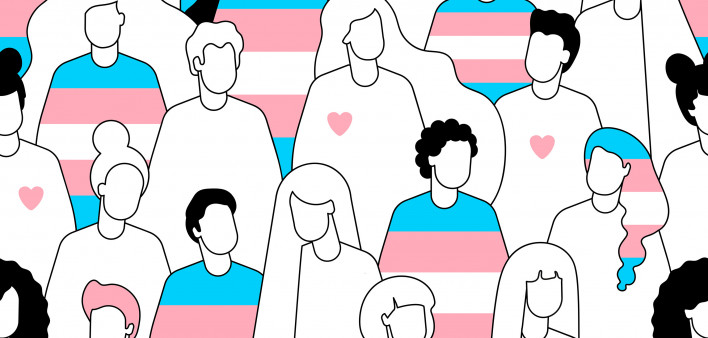Friday, March 31, marks the annual International Transgender Day of Visibility (#TDOV), a time to celebrate and honor transgender people and to raise awareness about the challenges they face. This year’s observance arrives as the transgender community faces public and legislative attacks, including bans on gender-affirming care for youth.
On Transgender Day of Visibility, we want you to know that we see you just as you are:
— President Biden (@POTUS) March 31, 2023
Made in the image of God and deserving of dignity, respect, and support.
We’ll never stop working to create a world where you won’t have to be brave just to be yourself. pic.twitter.com/g5TTZbv1UW
“Transgender Day of Visibility celebrates the joy, strength, and absolute courage of some of the bravest people I know—people who have too often had to put their jobs, relationships and lives on the line just to be their true selves,” writes President Joe Biden in a White House proclamation on the day. “Today, we show millions of transgender and nonbinary Americans that we see them, they belong, and they should be treated with dignity and respect. Their courage has given countless others strength, but no one should have to be brave just to be themselves. Every American deserves that freedom.”
Biden’s proclamation continues, “But today, too many transgender Americans are still denied those rights and freedoms. A wave of discriminatory state laws is targeting transgender youth, terrifying families and hurting kids who are not hurting anyone. An epidemic of violence against transgender women and girls, in particular women and girls of color, has taken lives far too soon. Last year’s Club Q shooting in Colorado was another painful example of this kind of violence — a stain on the conscience of our nation.”
A new report from the Williams Institute, part of the University of California, Los Angeles School of Law, puts numbers to Biden’s words. Highlights from the report note:
- An estimated 144,500 transgender youth and young adults ages 13 and older in the U.S. are at risk of being denied gender-affirming medical care due to enacted and proposed state bans and policies.
- As of March 24, 2023, 32 states have restricted access to gender-affirming care or have considered laws that would do so.
- An estimated 77,900 transgender youth live in 11 states that have enacted bans or taken executive actions to limit access to gender-affirming care. This includes 18,700 youth in Georgia, Iowa, Mississippi, South Dakota, Tennessee, and Utah, where bans have been signed into law this legislative session.
- An estimated 66,600 youth in 19 states remain in jeopardy of losing access to care if pending legislation is enacted. This includes Kentucky, where the state legislature has sufficient votes to override the Governor’s recent veto of a ban, and West Virginia, where a ban was passed but has not yet been signed.
“Research shows that gender-affirming care improves mental health and overall well-being for transgender people, including youth,” said study author Kerith J. Conron, of the Williams Institute, in a press statement. “Bans on access to medically appropriate health care add to the existing burden of stress experienced by transgender youth and their families.”
This International Transgender Day of Visibility, read @USAID_LGBTQI Senior Coordinator Jay Gilliam on how USAID is advancing the rights and inclusion of the international transgender????️⚧️community and other #LGBTQI+ groups. #TDOV https://t.co/2Npjuj4tyT
— USAID (@USAID) March 31, 2023
“These bills not only perpetuate harmful stereotypes and misinformation about transgender people but also seek to codify discrimination and transphobia into law,” added Elle Moxley, CEO of the Marsha P. Johnson Institute, in a separate statement, which also noted that, for transgender people, “existing is a radical act.”
“We are being actively, methodically and intentionally eradicated. We’re getting a front seat to how a society divides itself and turns against those that are different,” Moxley said. “They are not just trying to eradicate the existence of transgender individuals; they are eradicating anything that does not support the continued dominance of white, cis-gender men. This means it will not stop at transgender issues; it will continue to expand and spread and will redirect to the next segment of society that poses the next risk to their position.”
Hey Everyone, I just sent my words of support to spread love to trans youth! Follow the link to share your message today, then RT to show your support. https://t.co/XfEsFUaHJw
— Adv Maninderjit Singh (he/him) (@AdvManinderjit) March 31, 2023
Transgender visibility is also important in the HIV community because they are disproportionately affected by the epidemic. The POZ Basics on HIV and Transgender People explains the link:
Transgender, gender-nonconforming and nonbinary people have a higher rate of HIV than the population as a whole. However, accurate information about how many are affected has been scarce because of a lack of research and incomplete data collection.
About 1.4 million people in the United States identify as transgender, according to the Williams Institute, a research center at the University of California at Los Angeles that focuses on on sexual orientation and gender identity law and public policy. This translates to 0.6% of the nation’s population of 332 million people.
Transgender people accounted for 2% of the new HIV cases reported in 2019—or 671 diagnoses out of the 36,801 new cases that year—according to the Centers for Disease Control and Prevention (CDC). Over half the diagnoses were among transgender women who were Black (46%) or Latina (35%). Transgender men accounted for 46 cases in 2019; most of these were among Black and Latino people.
In related news, read “Extend Gender-Affirming Care To All,” a recent blog post from the Interrnational AIDS Society. And search #TDOV and #TransgenderDayofVisibility on social media to find statements and events marking this year’s observation. Several examples are posted throughout this article.







Comments
Comments